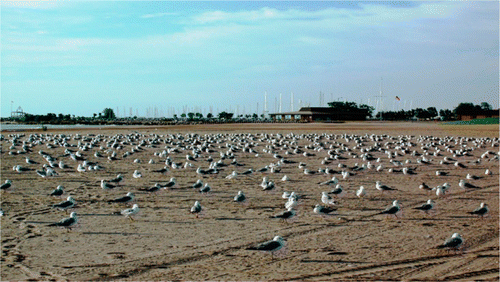September 7, 2012 report
EPA finds dogs are the best way to clear beaches of seagull guano

(Phys.org)—A slew of researchers working for the US Environmental Protection Agency have found that the best way to clear public beaches of bird guano and the hazardous bacteria that result, is to unleash trained dogs to harass them into moving elsewhere. The team has written a paper describing their results and have had it published in the journal Environmental Science & Technology.
As anyone that's ever visited a public beach knows, seagulls are a familiar and generally unwelcome sight, as they congregate over areas and leave behind enormous amounts of their feces. What's worse is that many bacteria that are hazardous to human health tend to show up in the guano which makes its way into both the sand and nearby waters. Beaches that are frequented by a lot of people are tested periodically for such bacteria and if levels grow too high, the beach must be closed for a time. In most cases, beaches are "cleaned" by turning over the sand, a time consuming and costly business.
To fight the problem, the EPA has tried using oils to cover bird eggs which prevent them from hatching; a method that offers some short term benefit, but not much in the long run; it's also quite labor intensive. In looking for new ways to solve the problem, the researchers noted anecdotal evidence that has suggested that when dogs are allowed on beaches, bird populations and the level of guano go down, though dog droppings of course, go up.
To find out if using dogs might be the solution if done in a proper way, the research team, led by Reagan Reed Converse, picked a beach in Racine Wisconsin, on Lake Michigan to serve as a study site. There they counted the number of birds present over an eleven day period and took sand and sea samples to measure the amount and kinds of bacteria as well. Next, they unleashed two border collies (with their handlers) that had been trained to chase seagulls on command, while leaving other less troublesome birds alone. The dogs kept the beach cleared of birds from morning till night for a week while the handlers kept the beach clear of dog doo.
The results showed the dogs truly did the trick. Prior to their arrival the researchers counted on average 665 birds on any given day; during the dog trial, that number fell to just 17. Also, prior to the introduction of the dogs, the researchers found hazardous bacteria present seven out of eleven days; when the dogs were working, they found none.
Because the results were so convincing, the EPA is now considering ways to implement beach patrols using trained dogs as a regular part of beach maintenance.
More information: Dramatic Improvements in Beach Water Quality Following Gull Removal, Environ. Sci. Technol., Article ASAP. DOI: 10.1021/es302306b
Abstract
Gulls are often cited as important contributors of fecal contamination to surface waters, and some recreational beaches have used gull control measures to improve microbial water quality. In this study, gulls were chased from a Lake Michigan beach using specially trained dogs, and water quality improvements were quantified. Fecal indicator bacteria and potentially pathogenic bacteria were measured before and during gull control using culture methods and quantitative polymerase chain reaction (qPCR). Harassment by dogs was an effective method of gull control: average daily gull populations fell from 665 before to 17 during intervention; and a significant reduction in the density of a gull-associated marker was observed (p < 0.001). Enterococcus spp. and Escherichia coli densities were also significantly reduced during gull control (p < 0.001 and p = 0.012, respectively for culture methods; p = 0.012 and p = 0.034, respectively for qPCR). Linear regression results indicate that a 50% reduction in gulls was associated with a 38% and 29% decrease in Enterococcus spp. and E. coli densities, respectively. Potentially human pathogenic bacteria were detected on 64% of days prior to gull control and absent during gull intervention, a significant reduction (p = 0.005). This study demonstrates that gull removal can be a highly successful beach remedial action to improve microbial water quality.
Journal information: Environmental Science & Technology
© 2012 Phys.org
















